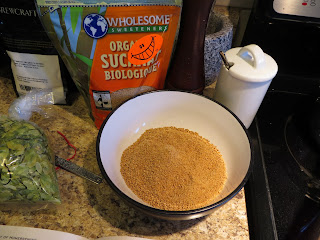Austin Homebrews Belgian White Beer (modified for 1 gallon batch and available ingredients)
4.32 lbs 2-row pilsner malt
2.73 lbs White Wheat Malt
2.27 lbs Flaked Wheat Malt (my supplier only had half this amount available, the other half we used torrified wheat)
0.45 oz Cascade (whole leaf @30min)
0.45 oz Cascade (whole leaf @5min)
0.5 oz Coriander Seed (@5min)
0.5 oz Bitter Orange Peel (@5min)
3944 Belgian Witbier Yeast
OG: 1.048
FG: 1.010
Boil: 60 min (75 min actual)
Primary Fermenter: 10 days
Secondary Fermenter: 14 days
We started by heating 3 gallons of water to ~145°F and added it and all our grain to the mash tun. The temperature was held at 135°F for 30min. ~5 quarts of boiling water was added to the mash tun to raise the temperature to 155°F for 45min. After that 5 quarts of wort was pull off, heated to boiling at added back to the mash tun for 5min (this raised the temperature to 167°F). It's worth noting, we would have added 5 quarts of boiling water, instead of pulling off wort, if we had a bigger mash tun.
After the final rest, we pulled off the wort and sparged with 6 gallons of water at 165°F. This yielded just shy of 6 gallons of wort. We added the hops and other additions per the recipe. After the hour long boil the specific gravity wasn't as high as we wanted, and we still had a little more than 5 gallons in the kettle. So we pulled out the hops (using a hop sock makes this easy) and left it to boil for another 15 min. We ended up hitting our specific gravity spot on!
We cooling it, chucked it in the fermenter (wort was at 24°C) and added it yeast. It's currently bubbling away all happy like.
Just as a note, the yeast takes 2-3 hours to proof, so be sure to do that right away so it's ready when you are.
Hopefully, I'll get some time in the coming weeks to keep working on the fridge/keggerator conversion.
 |
| Wort in the kettle |
 |
| Grains after sparging |
 |
| Bitter orange peel and coriander seed |



























